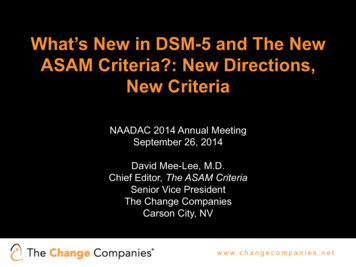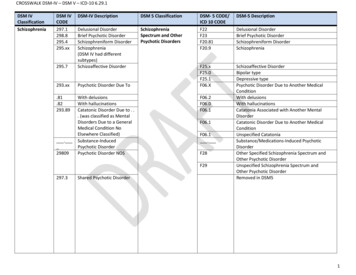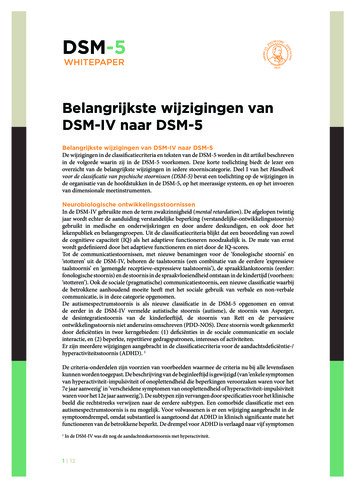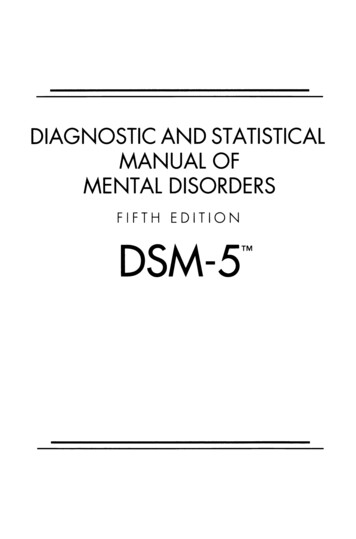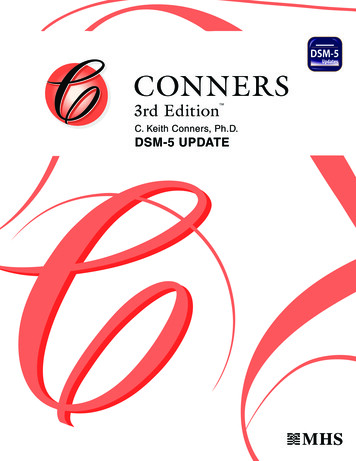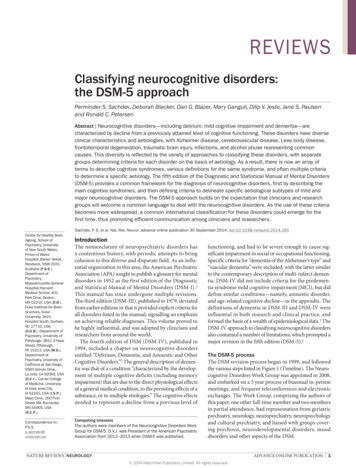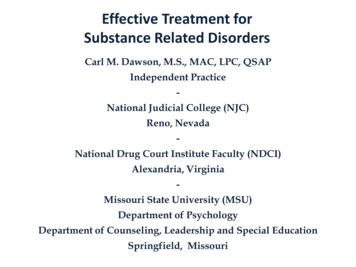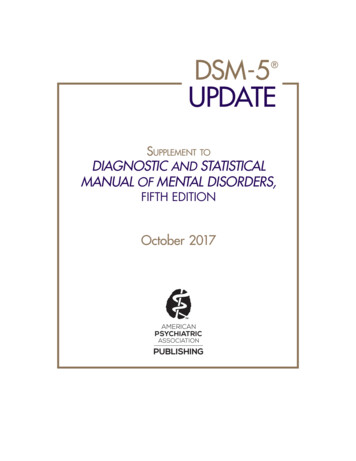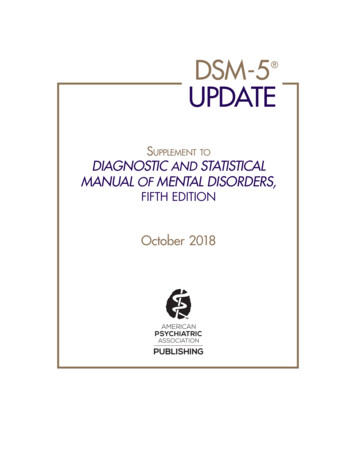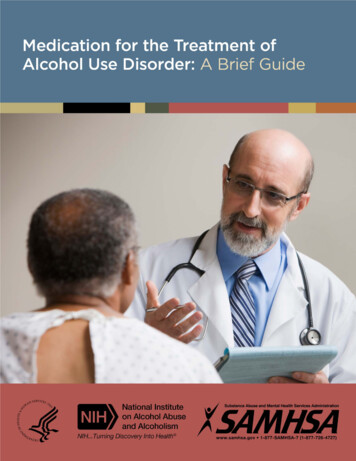
Transcription
NEW RESEARCHA Comparison of DSM-IV PervasiveDevelopmental Disorder and DSM-5 AutismSpectrum Disorder Prevalence in anEpidemiologic SampleYoung Shin Kim, MD, MS, MPH, PhD, Eric Fombonne, MD, Yun-Joo Koh, PhD,Soo-Jeong Kim, MD, Keun-Ah Cheon, MD, PhD, Bennett L. Leventhal, MDObjective: Changes in autism diagnostic criteria found in DSM-5 may affect autism spectrumdisorder (ASD) prevalence, research findings, diagnostic processes, and eligibility for clinicaland other services. Using our published, total-population Korean prevalence data, we computeDSM-5 ASD and social communication disorder (SCD) prevalence and compare them withDSM-IV pervasive developmental disorder (PDD) prevalence estimates. We also describeindividuals previously diagnosed with DSM-IV PDD when diagnoses change with DSM-5criteria. Method: The target population was all children from 7 to 12 years of age in a SouthKorean community (N ¼ 55,266), those in regular and special education schools, and adisability registry. We used the Autism Spectrum Screening Questionnaire for systematic,multi-informant screening. Parents of screen-positive children were offered comprehensiveassessments using standardized diagnostic procedures, including the Autism DiagnosticInterview–Revised and Autism Diagnostic Observation Schedule. Best-estimate clinical diagnoses were made using DSM-IV PDD and DSM-5 ASD and SCD criteria. Results: DSM-5ASD estimated prevalence was 2.20% (95% confidence interval ¼ 1.77–3.64). Combined DSM-5ASD and SCD prevalence was virtually the same as DSM-IV PDD prevalence (2.64%). Mostchildren with autistic disorder (99%), Asperger disorder (92%), and PDD-NOS (63%) metDSM-5 ASD criteria, whereas 1%, 8%, and 32%, respectively, met SCD criteria. All remainingchildren (2%) had other psychopathology, principally attention-deficit/hyperactivity disorderand anxiety disorder. Conclusion: Our findings suggest that most individuals with aprior DSM-IV PDD meet DSM-5 diagnostic criteria for ASD and SCD. PDD, ASD or SCD;extant diagnostic criteria identify a large, clinically meaningful group of individuals andfamilies who require evidence-based services. J. Am. Acad. Child Adolesc. Psychiatry,2014;53(5):500–508. Key Words: ASD, SCD, DSM-IV, DSM-5, prevalenceStudies of autism spectrum disorders (ASD),conducted since 1985, have reported progressively higher prevalence, with estimates ranging from 0.07% to 2.64%.1-4 Evidencesuggests that most prevalence changes areattributable to a combination of: greater publicThis article is discussed in an editorial by Dr. Bryan H. Kingon page 494.Clinical guidance is available at the end of this article.An interview with the author is available by podcast at www.jaacap.org or by scanning the QR code to the right.awareness, better case ascertainment, lower ageat diagnosis, diagnostic substitution, and changesin the diagnostic constructs and correspondingdiagnostic criteria.3In the American Psychiatric Association’sDiagnostic and Statistical Manual for Mental Disorders, 5th Edition (DSM-5), released in May 2013,5changes include major alterations in criteriafor developmental disorders, inparticular, the DSM-IV diagnosticcriteria for pervasive developmental disorder (PDD). Thesechanges include the following:elimination of PDD and the 5JOURNAL500www.jaacap.orgOF THEAMERICAN ACADEMY OF C HILD & ADOLESCENT PSYCHIATRYVOLUME 53 NUMBER 5 MAY 2014
ASD IN DSM-IV AND DSM-5subtypes found in DSM-IV; creation of a newdiagnostic category of ASD that is adapted to theindividual’s clinical presentation by inclusion ofclinical specifiers and associated features; changing from the DSM-IV PDD 3-domain criteria thatincluded social reciprocity, communication, andrestricted and repetitive behaviors (RRB) to 2DSM-5 ASD domain criteria composed of socialcommunication/interaction and RRB; for DSM-5,inclusion of sensory symptoms in the RRB component of diagnostic criteria; and, for DSM-5,changing the specification of the age of onset from“age 3” to “early childhood.” In addition, DSM-5adds a new diagnostic category, “social communication disorder (SCD).” SCD appears to includeindividuals who primarily have problems with thepragmatic aspects of social communication. According to DSM-5, individuals with SCD havedifficulties similar to those with ASD, but theseproblems are restricted solely to the realm of socialcommunication and do not include the DSM-5RRB criteria found in ASD.6Apparent differences between DSM-IV PDDand DSM-5 ASD criteria have led to debates, inboth the scientific and lay communities, overwhether these changes in diagnostic criteria willmaterially affect ASD prevalence, alter the wayin which individuals will be diagnosed withASD, and, possibly, affect the eligibility of individuals for clinical and other services. Suchdebates are creating controversy amongst professionals, as well as confusion and anxiety forservice providers, policy makers, and, mostimportantly, for patients and their families.7A number of investigators have attempted toaddress these important concerns by examiningthe reliability of the DSM-5 ASD criteria (with itssensitivity and specificity) against DSM-IV ASDcriteria, primarily using clinic-based samples ofindividuals with ASD. Results of these studiesinclude sensitivity ranging from 46% to 96% andspecificity from 53% to 100% (some were basedon different versions of draft DSM-5 criteria8-13).These studies appear to indicate that the DSM-5ASD criteria have reasonable sensitivity andspecificity against DSM-IV criteria. Nonetheless,there has been considerable debate, concern,and speculation with respect to how many individuals with DSM-IV PDD diagnoses will“lose diagnoses” with the advent of DSM-5.To answer these questions, in this article we willdirectly compare DSM-IV–based and DSM-5–based ASD prevalence estimates while also determining which individuals, if any, classified asDSM-IV PDD will not meet DSM-5 ASD diagnostic criteria. We will use rigorous epidemiologic methods with a total population approachthat includes both clinical and non-clinical populations of individuals with ASD, and systematicstandardized screening and diagnostic assessment.Using our total-population prevalence data froma recently completed and published study from aKorean cohort,4 we will do the following: Compute the DSM-5–based ASD and SCDprevalence estimates among children 7 to 12years of age Compare DSM-5 ASD and SCD prevalence estimates with DSM-IV PDD prevalence estimates Describe demographic, ASD-related clinicaland other associated characteristics of thoseindividuals with DSM-IV PDD diagnoses whowere classified with ASD or SCD in DSM-5versus those individuals with DSM-IV PDDwho no longer fell into either of these DSM-5categories.METHODStudy SubjectsThe target population (N ¼55,266) included all childrenborn from 1993 to 1999 (7–12 years of age at screening)in a suburb of Seoul, South Korea. Total populationscreening was conducted with both the Parents’ andTeachers’ Autism Spectrum Screening Questionnaire(ASSQ), using the mandatory elementary educationsystem and Disability Registry (DR). This total population approach allowed us to include and examinechildren with ASD who have used service systems,including health care and educational services (a clinical ASD population whom we labeled the “highprobability group” [HPG]), as well as those childrenwith ASD who never received any services (a nonclinical sample with ASD whom we labeled the “general population sample” [GPS]).Children were considered to be screen positivewith Teacher-ASSQ scores 10 and/or Parent-ASSQscores in the top 2nd percentile. Additional screenpositive individuals came from a random sample of50% of children in the 3rd percentile, and 33% ofstudents in the 4th and 5th percentiles of Parent-ASSQscores for children in regular education schools. Allchildren in the DR and attending special educationschools with diagnoses of ASD/intellectual disability(ID) were considered screen positive. Screen-positivechildren were evaluated using standardized diagnostic assessments, as follows: the Autism DiagnosticObservation Schedule (ADOS), Autism DiagnosticInterview–Revised (ADI-R), cognitive tests (KoreanWechsler Intelligence Scale for Children–III and LeiterJOURNAL OF THE AMERICAN ACADEMY OF C HILD & ADOLESCENT PSYCHIATRYVOLUME 53 NUMBER 5 MAY 2014www.jaacap.org501
KIM et al.International Performance Scale–Revised), and Behavioral Assessment System for Children II–Parent ReportScale (BASC II-PRS) validated in Korean children. Finalbest estimate clinical diagnoses were made using allsystematically obtained, relevant data based on DSMIV PDD diagnostic criteria. Each diagnostic teamincluded 1 board-certified Korean child psychiatrist,trained both in Korea and the United States, plusa second board-certified child psychiatrist or childpsychologist (team 1: Drs. Y.S. Kim and Cheon; team2: Drs. Koh and S.-J. Kim). Disagreements wereresolved by reaching consensus between diagnosingclinicians. There was 98% agreement among Koreandiagnosticians and 100% agreement among NorthAmerican senior investigators (Drs. Fombonne andLeventhal). The 2% initially discordant diagnoseswere resolved in discussions among all investigators.Detailed case identification processes, validity, andreliability of best estimate diagnoses are described inour 2011 publication.4Using this identical study population, case identification, confirmative diagnosis, and statistical methods,we re-evaluated all of the screen-positive individualswho completed confirmative diagnostic assessment fromour original study to establish diagnoses for DSM-IVPDD subtypes, DSM-5 ASD, and DSM-5 SCD, and tocompute DSM-5–based ASD and SCD prevalence estimates. Of 292 cases, 60 (21%) were randomly chosento examine diagnostic reliability for DSM-5 ASD andSCD criteria, for which each Korean team reachedconsensus diagnoses in all cases.In addition to the reassessment of diagnoses forall cases, we divided the children who were ASSQscreen positive and completed diagnostic assessment in3 groups, according to the level of agreement betweenDSM-IV PDD and DSM-5 ASD diagnostic criteria: Divergent (D): children with a DSM-IV PDD diagnosis who did not have a DSM-5 ASD diagnosis;(DSM-IV PDD[þ]/DSM-5 ASD[ ]; discrepant casesof DSM-IV PDD[ ]/DSM-5 ASD[þ] were absentand therefore not included in the analyses). Divergent cases were further divided into 2 groups according to the new diagnoses received, includingD-SCD (those with final diagnoses of SCD with/without comorbid psychiatric disorders) and D-other(those with final diagnoses of other psychiatricdisorders). ASD Convergent: children who met both DSM-IVPDD criteria and DSM-5 ASD criteria (DSM-IV PDD[þ]/DSM-5ASD[þ]) No ASD Convergent: children who did not meeteither DSM-IV PDD or DSM-5 ASD criteria aftercompletion of the full assessment (DSM-IV PDD[ ]/DSM-5 ASD [ ]).Data AnalysesThe denominator used to compute ASD prevalencewas the entire target population (N ¼ 55,266) to reflectvariance arising from non-participants.4 Prevalenceestimates by sex and ASD subtypes in the total population, as well as in the HPG and GPS, were computedusing the SAS 9.1 Proc Frequency procedure (SASInstitute, Cary, NC).4 Several strategies were usedto adjust for missing data from screen-positive nonparticipants. Detailed methods to adjust for missingdata and compute prevalence estimates are describedin our 2011 publication.4We used c2 statistics and analysis of variance(ANOVA) with Scheff e post hoc analyses to comparedemographic, ASD-related clinical and other associatedcharacteristics of these 3 groups. A detailed descriptionof the participants is provided in our 2011 publication.4RESULTSOf 55,266 children 7 to 12 years of age, 36,886children attended 33 participating elementaryschools (from total 43 schools) and/or wereenrolled in a DR. Parents of 23,337 childrenreturned ASSQs (63% response). Of the 1,214sampled screen-positive students, 869 (72%) parents consented to participate in the diagnosticstage (70% male), and 292 (34%) completed diagnostic assessment.Prevalence Estimates of DSM-IV PDDUsing DSM-IV criteria, we previously reported anestimated PDD prevalence of 2.64% (95% CI ¼1.91–3.37%) in a total population. We also foundthat the estimated DSM-IV PDD prevalence was1.89% (1.43–2.36%) in the GPS and, total population prevalence estimate of ASD drawn from theHPG was 0.75% (0.58–0.93%), with a much higherproportion of children with ASD in the HPG.Total male and female DSM-IV PDD prevalencewere 3.74% (2.57–4.90%) and 1.47% (0.60–2.37%),respectively, indicating a sex ratio of 2.5:1. Inaddition, we further classified DSM-IV PDDby subtypes and computed prevalence estimatesfor autistic disorder, Asperger disorder, andPDD-NOS, which were 1.04% (0.79–1.30%), 0.60%(0.33–0.87%), and 1.00% (0.66–1.34%), respectively (Table 1).Prevalence Estimates of DSM-5 ASDThe estimated total population prevalence ofDSM-5 ASD was 2.20% (1.77–2.64%). This isclearly different from the DSM-IV PDD-estimatedtotal population prevalence of 2.64%. However,examination of these data suggests that theentirety of this difference comes from thoseindividuals found in the generally higherfunctioning, lower service use, GPS sample; thatJOURNAL502www.jaacap.orgOF THEAMERICAN ACADEMY OF C HILD & ADOLESCENT PSYCHIATRYVOLUME 53 NUMBER 5 MAY 2014
ASD IN DSM-IV AND DSM-5TABLE 1 Prevalence Estimates:a DSM-IV Pervasive Developmental Disorder (PDD), DSM-5 Autism Spectrum Disorder(ASD), and DSM-5 Social Communication Disorder (SCD)PopulationTotalGPSHPGDSM-IV PDD SubtypesAutistic DisorderAspergerPDD-NOSSexMaleFemaleDSM-IV PDD% (95% CI)DSM-5 ASD% (95% CI)DSM-5 SCD% (95% CI)DSM-5 ASDþSCD% (95% CI)2.64 (1.91-3.37)1.89 (1.43-2.36)0.75 (0.58-0.93)2.20 (1.77-2.64)1.46 (1.06-1.85)0.75 (0.57-0.92)0.49 (0.21-0.77)0.49 (0.21-0.77)0.002.70 (2.18-3.21)1.95 (1.46-2.43)0.75 (0.57-0.92)1.04 (0.79-1.30)0.60 (0.33-0.87)1.00 (0.66-1.34)1.03 (0.78-1.29)0.55 (0.29-0.80)0.63 (0.38-0.87)0.01 (0.00-0.03)0.05 (0.00-0.13)0.32 (0.09-0.54)1.04 (0.79-1.30)0.59 (0.33-0.86)0.94 (0.61-1.28)3.74 (2.57-4.90)1.47 (0.60-2.37)3.16 (2.47-3.85)1.17 (0.62-1.72)0.56 (0.17-0.95)0.42 (0.02-0.81)3.71 (2.92-4.51)1.58 (0.90-2.26)Note: GPS ¼ general population sample; HPG ¼ high-probability group; NOS ¼ not otherwise specified.aFrom a representative total population of Korean school-aged children.is, the GPS DSM-IV PDD prevalence was1.89% versus the GPS DSM-5 ASD prevalence of1.46% (1.06–1.85%). Furthermore, this conclusionis supported by analyses indicating that the estimated prevalence of DSM-5 HPG ASD, 0.75%(0.58–0.93%), is virtually identical to the DSM-IVPDD prevalence in that same HPG population:0.75% (0.57–0.92%).Changes From DSM-IV PDD Diagnoses WhenDSM-5 ASD Criteria Are AppliedThis can be further divided into 3 importantquestions: What happens to the children with DSM-IVAutistic Disorder (n ¼ 114) when DSM-5criteria are applied?Answer: 99% (n ¼ 112) have DSM-5 ASD; 1%(n ¼ 2) have SCD. What happens to the children with DSM-IVAsperger disorder (n ¼ 34) when DSM-5criteria are applied?Answer: 91% (n ¼ 31) have DSM-5 ASD; 6%(n ¼ 2) have SCD; 3% (n ¼ 1) have anotherpsychiatric disorder. Finally, what happens to the children withDSM-IV PDD-NOS (n ¼ 58) when DSM-5criteria are applied?Answer: 71% (n ¼ 41) have DSM-5 ASD; 22%(n ¼ 13) have SCD; 7% (n ¼ 4) have other,non-ASD or non-SCD disordersDSM-5 male and female ASD prevalenceestimates are 3.16% (2.47–3.85%) and 1.17%(0.62–1.72%), respectively, indicating a sex ratioof 2.7:1.Prevalence Estimates of SCDWe computed the estimated prevalence for SCDas 0.49% (0.21–0.77%). SCD cases were identifiedonly in the GPS (0.49%); that is, there were noSCD cases coming from the HPG group. Indeed,the largest proportion of children with DSM-5SCD was from those previously diagnosed withDSM-IV PDD-NOS (0.32% [0.09–0.54%]); veryfew of these children had been previously diagnosed with DSM-IV Asperger disorder (0.05%[9.00–0.13%]). Furthermore, male and femaleprevalence estimates for SCD were 0.56% (0.17–0.95%) and 0.42% (0.02–0.81%), respectively, witha sex ratio of 1.3:1.Because DSM-5 ASD and SCD together seemto almost completely overlap with DSM-IV PDD,we attempted to examine how many childrenactually met criteria for a disorder characterizedby clinically significant difficulties with socialreciprocity. To do this, we combined the data forDSM-5 ASD and SCD to calculate the combinedprevalence estimate. Using this strategy, it appearsthat the prevalence estimate for the DSM-IVPDD is almost identical to that of the combinedDSM-5 ASD þ SCD (2.7%) for every category,including the total population, as well as theGPS, HPG, ASD subtypes, and sex (Table 1).Characteristics of Convergent/Divergent Cases ofDSM-IV PDD and DSM-5 ASD DiagnosesFinally, we examined the characteristics of thosechildren whose diagnoses found convergencebetween DSM-IV and DSM-5 and those whosediagnoses were divergent. Of 292 confirmativediagnostic assessment completers, 270 (92%) hadJOURNAL OF THE AMERICAN ACADEMY OF C HILD & ADOLESCENT PSYCHIATRYVOLUME 53 NUMBER 5 MAY 2014www.jaacap.org503
KIM et al.convergent diagnoses by DSM-IV PDD andDSM-5 ASD criteria. That is, of these 292 screenpositive children, 63% (n ¼ 184) eventually hadboth DSM-IV PDD and DSM-5 ASD, thus indicating convergence between DSM-IV and DSM-5;another 29% (n ¼ 86) did not have either a finalDSM-IV PDD or DSM-5 ASD diagnosis, meaning that they were also convergent but, in thisinstance, for no diagnosis.However, there were 22 cases (8%) for whichthe DSM-IV PDD and DSM-5 ASD diagnoseswere divergent; that is, the DSM-IV PDD and theDSM-5 ASD diagnoses did not overlap. Based onthis, one can conclude that 92% of individualsreceived similar diagnoses when both DSM-IVand DSM-5 criteria were applied. For the divergent cases, even though the PDD/ASD diagnosesdid not overlap, all children still had a diagnosisof some form of developmental psychopathology.Of these 22 divergent cases, 17 (77%) movedfrom autistic disorder (n ¼ 2), Asperger disorder(n ¼ 2), and PDD-NOS (n ¼ 13) to DSM-5 SCD.In fact, all of the divergent DSM-IV autistic disorder cases moved to SCD, as did most of theAsperger and PDD-NOS cases. Ultimately, therewere 5 case individuals who had a DSM-IV PDDdiagnosis but did not meet criteria for either DSM5 ASD or SCD. One was a child with DSM-IVAsperger disorder who met criteria for attentiondeficit/hyperactivity disorder (ADHD), as did 1child with DSM-IV PDD-NOS. All of the remaining divergent PDD-NOS cases (n ¼ 3) met criteriafor anxiety disorder. There were no age differencesamong the 3 groups; however, more boys werepresent in the ASD-convergent group, comparedto the divergent group and the screen-positivechildren who ultimately were in the “no ASD”(nASD)-convergent groups (Table 2).Significant differences in several aspects ofASD-related clinical characteristics emergedamong the 3 groups (Table 3): ASSQ mean scores differed only between theno ASD–convergent and the ASD-convergentgroups, with significantly higher scores in theASD-convergent group. SRS total and subscale scores, except the motivation subscale in the ASD-convergent group,were significantly higher than those in theremaining 2 groups. When ADI-R and ADOS algorithm scores wereexamined, social reciprocity differed from eachother on both the ADOS and ADI-R, with higherlevels of impairment in the ASD-convergentgroup followed by the ASD-divergent groupand then the no ASD–convergent group. In contrast, the ADI-R communication scores weresignificantly higher only in the ASD-convergentgroup when compared to the other 2 groups. ADOS communication scores differed in all3 groups, with the most impairment in theASD-convergent group followed by the ASDdivergent group and then the no ASD–convergent group. In addition, stereotypy scores were significantly higher only in the ASD-convergentgroup when compared to the other 2 groups,using both the ADOS and ADI-R.TABLE 2 Demographic Characteristics of DSM-IV Pervasive Developmental Disorder (PDD) – DSM-5 Autism SpectrumDisorder (ASD) Convergent (C)/Divergent (D) Cases (N ¼ 292)Divergent GroupDIVa (n ¼ 22)Other diagnoses, n (%)SCDSCD and other psychiatric disordersOther psychiatric disordersNo diagnosesSex, n (%)dMaleFemaleAge, y, mean SDe14350Convergent GroupC-nASDb (n ¼ 86)(64)(14)(22)(0)21542914 (64)8 (36)10.6 1.7(2)(1)(63)(34)54 (63)32 (37)c10.1 1.8C-ASDc (n ¼ 184)0039145p(0)(0)(21)(79)145 (79)39 (21)b10.1 1.7.013.494Note: C-ASD ¼ convergent for ASD (PDD[þ]/ASD[þ]); C-nASD ¼ convergent for no ASD (PDD[ ]/ASD[ ]); DIV ¼ divergent for DSM-IV PDD and DSM-5ASD (PDD[þ]/ASD[ ]); SCD ¼ social communication disorder.a,b,cSignificant group differences.dThe c2 test (2 df) was used to examine sex differences.eAnalysis of variance (ANOVA) with Scheff e post hoc analyses was used to examine age differences among DIS, A-nASD, and A-ASD groups.JOURNAL504www.jaacap.orgOF THEAMERICAN ACADEMY OF C HILD & ADOLESCENT PSYCHIATRYVOLUME 53 NUMBER 5 MAY 2014
ASD IN DSM-IV AND DSM-5TABLE 3 Autism Spectrum Disorder (ASD)–Related Clinical Characteristics of DSM-IV Pervasive DevelopmentalDisorder (PDD)–DSM-5 ASD Convergent (C)/Divergent (D) Cases (N ¼ 292)Convergent Group (n ¼ 274)aIntellectual deficit***Performance IQ,*** mean SDASSQ parents,** mean (min, max)ADI-R algorithm scores, mean SDSocial reciprocity***Communication***Stereotypies***Onset 36 monthsd***ADOS algorithm scores, mean SDSocial nation***Divergent Group (n ¼ 22)C-nASD (n ¼ 86)C-ASD (n ¼ 188)D-SCD (n ¼ 17)D-Otherd (n ¼ 5)6 (7%)99 18b20 (2, 46)b58 (32%)86 27a27 (0, 54)a2 (11.8%)100 1721 (14, 28)0 (0.0%)97 1520 (6, 33)5.2 4.0b,c6.3 3.7b2.0 1.5b30 (35.3%)17.8 7.5a,c13.8 4.9a,c,d4.8 2.5a,c154 (84.6%)12.3 6.5a,b9.2 3.8b2.1 2.3b4 (76.5%)10.0 7.08.0 4.7b2.2 0.81 (40.4%)2.81.50.70.5 b2.5b,c,d1.2b,c0.8b0.6b8.74.11.91.3 2.8a2.1a1.6a,c1.0ac7.13.00.70.7 3.0a2.0a0.9b0.86.62.80.21.0 1.5a1.60.40.7Note: ASSQ ¼ Autism Spectrum Screening Questionnaire; ADI-R ¼ Autism Diagnostic IntervieweRevised; ADOS ¼ Autism Diagnostic ObservationSchedule; C-ASD ¼ convergent for ASD (PDD[þ]/ASD[þ]); C-nASD ¼ convergent for no ASD (PDD[ ]/ASD[ ]); D-social communication disorder(SCD) ¼ divergent for DSM-IV PDD and DSM-5 ASD (PDD[þ]/ASD[ ]) with final diagnosis of DSM-5 SCD Diagnosis; D-other ¼ divergent for DSM-IVPDD and DSM-5 ASD (PDD[þ]/ASD[ ]) with final diagnosis of DSM-5 other psychiatric disorders; max ¼ maximum; min ¼ minimum.All other statistical tests were performed with analysis of variance with Scheff e post hoc analyses to examine differences in ASD-related clinicalcharacteristics among C-nASD, C-ASD, D-SCD, and D-other groups.a,b,cSignificant group differences by statistical tests (**p .005; ***p .001).d 2c test (2 df). Onset of symptoms differed among the 3 groups,with the earliest onset occurring in the ASDconvergent group, followed by ASD-divergentgroup and the no ASD–convergent group. Differences in imagination on the ADOS wereobserved only between the ASD-convergentand no ASD–convergent groups.Table 4 summarizes the BASC II-PRS mean Tscores of 9 clinical subscales, externalizing andinternalizing subscales, and 5 adaptive compositescores in the 3 groups. Of the clinical subscales,the anxiety score for the divergent group wassignificantly higher compared to that of theASD-convergent group; however, there were nodifferences between the remaining groups. Thewithdrawal score was significantly higher in theASD-convergent group when compared to the noASD–convergent group uals (71%) with a DSM-IVPDD-NOS diagnosis have DSM-5 ASD, but asignificant number (w29%) change. Such diagnostic changes occur exclusively among those individuals with a PDD-NOS diagnosis who wereidentified among the GPS, a group characterizedby milder ASD symptoms, average intelligence,and less functional impairment.4 In addition, thesechanges occurred evenly between boys and girls.When reviewing profiles of the 22 case individuals with diagnostic shifts, we found thateven though they were divergent on the basis ofDSM-IV PDD and DSM-5 ASD diagnoses, all ofthese children still had a diagnosis of some formof developmental psychopathology. In fact, all ofthe divergent DSM-IV autistic disorder case subjects moved to SCD, as did most of the Aspergerdisorder and PDD-NOS case subjects (76%).Among the 17 divergent case individuals whomoved from DSM-IV PDD to SCD, the reasonwas primarily related to a relatively low level ofRRBs, as seen in the ADOS and ADI-R stereotypyscores (Table 3). The remaining 5 divergent casesubjects had other forms of psychopathology, andalso had lower SRS scores, higher BASC anxietyscores, and higher ADOS scores for overactivityand anxiety codes. Otherwise, they appearedsimilar to the other divergent case subjects withrespect to demographics, cognitive level, ADOSand ADI-R algorithm scores, and parental ASSQresponses (data not shown). This suggests that forchildren who no longer met criteria for ASD orSCD, their social and behavioral disruptions werelikely associated with ADHD or anxiety disorder;however, the sample size is too small for furthermeaningful statistical analyses.We report that the estimated prevalence forSCD ¼ 0.49% in this community-ascertained population of school-aged children. Although mostSCD cases came from previous DSM-IV PDDNOS cases, we identified 3 new SCD case subjects (2 girls and 1 boy) who did not have a priorPDD diagnosis. All of these children had significant difficulties in communication accompaniedJOURNAL506www.jaacap.orgOF THEAMERICAN ACADEMY OF C HILD & ADOLESCENT PSYCHIATRYVOLUME 53 NUMBER 5 MAY 2014
ASD IN DSM-IV AND DSM-5by a moderate lack of social reciprocity, basedon both parental survey and direct interview; inaddition, they all have modest difficulties incommunication, as well as mild socia
agnoses were made using DSM-IV PDD and DSM-5 ASD and SCD criteria. Results: DSM-5 ASD estimated prevalence was 2.20% (95% confidence interval ¼ 1.77-3.64). Combined DSM-5 ASD and SCD prevalence was virtually the same as DSM-IV PDD prevalence (2.64%). Most children with autistic disorder (99%), Asperger disorder (92%), and PDD-NOS (63%) met
